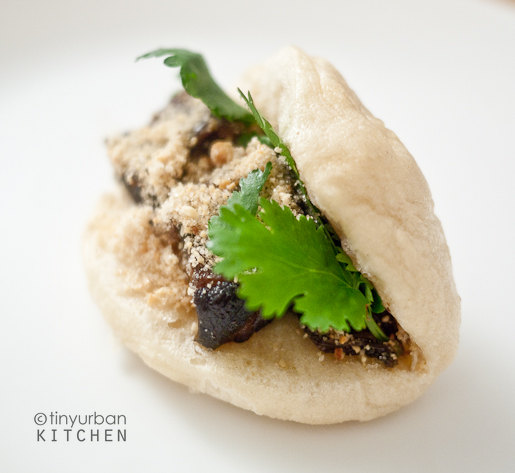
There are so many variations for making steamed buns, and they vary in their complexity. Some use shortening, others use butter; some require making a dough starter, while others use regular flour. Some add milk, some even use Bisquick (!) as a starting material! Finally, some preparations take multiple days, while others can be done in an afternoon.
I've actually tried the Bisquick method, which works great if you're super short on time (no need for yeast!) but the results are only so-so. I decided this time I would actually try to make a yeast-based bun from scratch.
I've actually tried the Bisquick method, which works great if you're super short on time (no need for yeast!) but the results are only so-so. I decided this time I would actually try to make a yeast-based bun from scratch.
The cookbook I was using had two methods: a home kitchen method that only took a few hours and only had 6 ingredients; and a bakery/restaurant method that not only seemed to have twice as many ingredients, it took multiple days and required making a dough starter.
Since this was my first time making steamed bread, I decided not to be too ambitious and decided to try the "home kitchen" method. The book said that the home version would create steamed bread with larger air bubbles, and thus less the buns would be less refined. The restaurant version, on the other hand, would result in a super light and delicate bun "with a delicious flavor".
I found this home method to be pretty do-able, although it still involved several steps, a reasonable amount of equipment, and quite a few hours.
Homemade Steamed Buns (Baos)
Ingredients
1/4 cup sugar
1 3/4 cup warm water
6 cups all-purpose flour
2 T shortening
1 T yeast
1 T baking powder

Yeast + sugar + warm water after about 10-15 minutes at room temperature
Dissolve sugar in warm water and add the yeast. Let the liquid stand at room temperature for about 10 minutes, or until it becomes foamy (see picture above). Sift flour into a separate bowl. To the flour add shortening, the yeast/sugar mixture, and baking soda. Mix well. Knead the dough until smooth and elastic. Add additional flour or water as necessary to make the dough the right consistency (smooth yet pliable).

Top left and Top right: kneading dough. Bottom left: dough in plastic wrap left to warm. Bottom right: dough after rising for about 2 hours
Cover the bowl tightly with plastic wrap let it rise in a warm place for about 2 hours or until it has tripled in bulk.
Top Left: Post risen kneaded dough. Top Right: dough logs and sliced dough. Bottom Left: dough discs with a dab of sesame oil. Bottom right: half moon buns for making gua bao
Knead the (now tripled in size) dough until smooth. Shape into logs and slice into about 20 pieces. If you are just making steamed bread (mantou), proceed to the next step with the sliced pieces. If you want to make gua bao or other sorts of sandwich buns, lightly flatten each piece, brush with sesame oil, and fold it over on itself like a half moon.
To prevent sticking, I like to place each bun on a square of wax paper. Let the buns rest at room temperature for 10-30 minutes. Do not let them rest for longer than 30 minutes or else they will start to deflate.
Steam the buns in a steamer (ideally a bamboo steamer) over boiling water for ~8 minutes. If you don't have a bamboo steamer, you can use double layered pasta cooker (see how I've improvised with parts from both the steamer and my pasta maker?).
If you are making plain steamed buns (mantou), you can just serve with other condiments. If you are making steamed bun sandwiches (like gua bao), fill with desired fillings and then serve.

Final Thoughts
This "home cook" bun definitely pales in comparison to any restaurant version, or any frozen supermarket version. It's much less refined, and frankly, isn't nearly as good. It's a bit chewier, a little less fluffy. I almost think it's not worth all that effort when you can get much better ones in the freezer section of your local Asian supermarket. The flavor is decent, but you aren't going to get that nice fluffy and delicate texture that you see in the restaurant versions.
I would be curious to know if anyone else has tried a better home steamed bun recipe? Do you really have to use a multi-step dough starter method to achieve that glorious refined bakery-like texture? I've seen the Momofuku recipe but haven't tried that version.
In any event, it was fun to try, but for now, I may just stick to buying bakery buns and filling it with my own braised pork belly instead of slaving away at inferior buns!
Having said that, making buns is still a fun activity at home, and the buns still taste decent. It's definitely not a bad activity to do with kids at home. As kids, my sister and I had tons of fun making steamed bun versions of turtles, snowmen, and all sorts of characters. You can never replicate that in a restaurant. :)
Related posts
Gua Bao





No comments :
Post a Comment